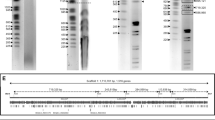Abstract
InPodospora anserina the longevity inducing linear plasmid pAL2-1 was transferred from the extrachromosomal long-lived mutant AL2 to the shor-tlived wild-type strain A. The resulting strain, AL2-IV, exhibited the long-lived phenotype. In the short-lived progeny of crosses between this strain and wild-type strain A, the plasmid was absent. In contrast, all long-lived progeny contained both the autonomous plasmid as well as copies of it integrated in the mitochondrial DNA (mtDNA). Molecular analysis revealed that the integrated plasmid copies most likely resulted from ade novo integration of the autonomous element and the generation of AT-linker sequences at the integration site. We conclude that once the plasmid is present in mitochondria of a particular genetic background, it is able to integrate into the mtDNA and to induce longevity.
Similar content being viewed by others
References
Arganoza MT, Min J, Hu Z, Akins RA (1994) Distribution of seven homology groups of mitochondrial plasmids inNeurospora: evidence for widespread mobility between species in nature. Curr Genet 26:62–73
Belcour L, Rossignal M, Sellem C, Oldani C (1992) Plasticity and instability of the mitochondrial genome inPodospora anserina. Abstract 1st Eur Conf Fungal Genet, Nottingham, OP1/1
Bernet J (1988)Podospora growth-control mutations inhibit apical cell anastomosis and protoperithecium formation. Exp Mycology 12:217–222
Collins RA, Saville BJ (1990) Independent transfer of mitochondrial chromosomes and plasmids during unstable vegetative fusion inNeurospora. Nature 345:177–179
Cummings DJ, Belcour L, Grandchamp C (1979) Mitochondrial DNA fromPodospora anserina. II. Properties of mutant DNA and multimeric circular DNA from senescent cultures. Mol Gen Genet 171:239–250
Cummings DJ, McNeil IA, Domenico JM, Matsuura ET (1985) Excision-amplification of mitochondrial DNA during senescence inPodospora anserina. DNA sequence analysis of three unique “plasmids”. J Mol Biol 185:659–680
Debets F, Yang X, Griffiths AJF (1994) Vegetative incompatibility inNeurospora: its effect on horizontal transfer of mitochondrial plasmids and senescence in natural populations. Curr Genet 26:113–119
Esser K (1974)Podospora anserina. In: King RC (ed) Handbook of genetics, vol I. Plenum Press, New York, pp 531–551
Esser K (1985) Genetic control of aging. The mobile intron model. In: Bergener M, Ermini M, Stähelin HB (eds) The 1984 Sandoz Lectures in gerontology, Thresholds in aging Academic Press London, pp 3–20
Griffiths AJF, Kraus SR, Barton R, Court DA, Myers CJ, Bertrand H (1990) Heterokaryotic transmission of senescence plasmid DNA inNeurospora. Curr Genet 17:139–145
Griffiths AJF, Yang X, Barton R, Myers C (1992) Suppression of cytoplasmic senescence inNeurospora. Curr Genet 21:479–484
Hermanns J, Osiewacz HD (1992) The linear mitochondrial plasmid pAL2-1 of long-livedPodospora anserina mutantAL2 is an invertron encoding a DNA and RNA polymerase. Curr Genet 22:491–500
Hermanns J, Osiewacz HD (1994) Three mitochondrial unassigned open reading frames ofPodospora anserina represent remnants of a viral-type RNA polymerase gene. Curr Genet 25:150–157
Hermanns J, Asseburg A, Osiewacz HD (1994) Evidence for a life span-prolonging effect of a linear plasmid in a longevity mutant ofPodospora anserina. Mol Gen Genet 243: 297–307
Hermanns J, Asseburg A, Osiewacz HD (1995 a) Evidence for giant linear plasmids in the ascomycetePodospora anserina. Curr Genet 27:379–386
Hermanns J, Debets F, Hoekstra R, Osiewacz HD (1995 b) A novel family of linear plasmids with homology to plasmid pAL2-1 ofPodospora anserina. Mol Gen Genet 246:638–647
Kellner M, Burmester A, Wöstemeyer A, Wöstemeyer J (1993) Transfer of genetic information from the mycoparasiteParasitella parasitica to its hostAbsidia glauca. Curr Genet 23:334–337
Kempken F (1995) Horizontal gene transfer of a mitochondrial plasmid. Mol Gen Genet 248:89–94
Kempken F, Hermanns J, Osiewacz HD (1992) Evolution of linear plasmids. J Mol Evol 35:502–513
Kück U (1989) Mitochondrial DNA rearrangements inPodospora anserina. Exp Mycol 13:111–120
Marcou D (1961) Notion de longévité et nature cytoplasmique de déterminant de la sénescence chez quelque champignons. Ann Sci Nat Bot 12:653–764
Osiewacz HD (1995) Aging and genetic instabilities. In: Esser K, Martin GM (eds) Molecular aspects of aging. Wiley and Sons, Chichester, pp 29–44
Osiewacz HD, Esser K (1984) The mitochondrial plasmid ofPodospora anserina, a mobile intron of a mitrochondrial gene. Curr Genet 8:299–305
Osiewacz HD, Hermanns J, Marcou D, Triffi M, Esser K (1989) Mitochondrial DNA rearrangements are correlated with a delayed amplification of the mobile intron (pIDNA) in a long-lived mutant ofPodospora anserina. Mutat Res 219:9–15
Sainsard-Chanet A, Begel O, Belcour L (1993) DNA deletion of mitochondrial introns is correlated with the process of senescence inPodospora anserina. J Mol Biol 234:1–7
Sambrook J, Fritsch EF, Maniatis T (1989) Molecular cloning: a laboratory manual, 2nd edn. Cold Spring Harbor Laboratory, Cold Spring Harbor, New York
Sellem CH, Lecellier G, Belcour L (1993) Transposition of a group-II intron. Nature 366:176–178
Stahl U, Lemke PA, Tudzynski P, Kück U, Esser K (1978) Evidence for a plasmid-like DNA in a filamentous fungus, the ascomycetePodospora anserina. Mol Gen Genet 162:341–343
Turker MS, Domenico JM, Cummings DJ (1987) A novel family of mitochondrial plasmids associated with longevity mutants ofPodospora anserina. J Biol Chem 262:2250–2255
Yang X, Griffiths AJF (1993) Plasmid diversity in senescent and nonsenescent strains ofNeurospora. Mol Gen Genet 237: 177–186
Author information
Authors and Affiliations
Additional information
Communicated by K. Wolf
Rights and permissions
About this article
Cite this article
Hermanns, J., Osiewacz, H.D. Induction of longevity by cytoplasmic transfer of a linear plasmid inPodospora anserina . Curr Genet 29, 250–256 (1996). https://doi.org/10.1007/BF02221555
Received:
Issue Date:
DOI: https://doi.org/10.1007/BF02221555




